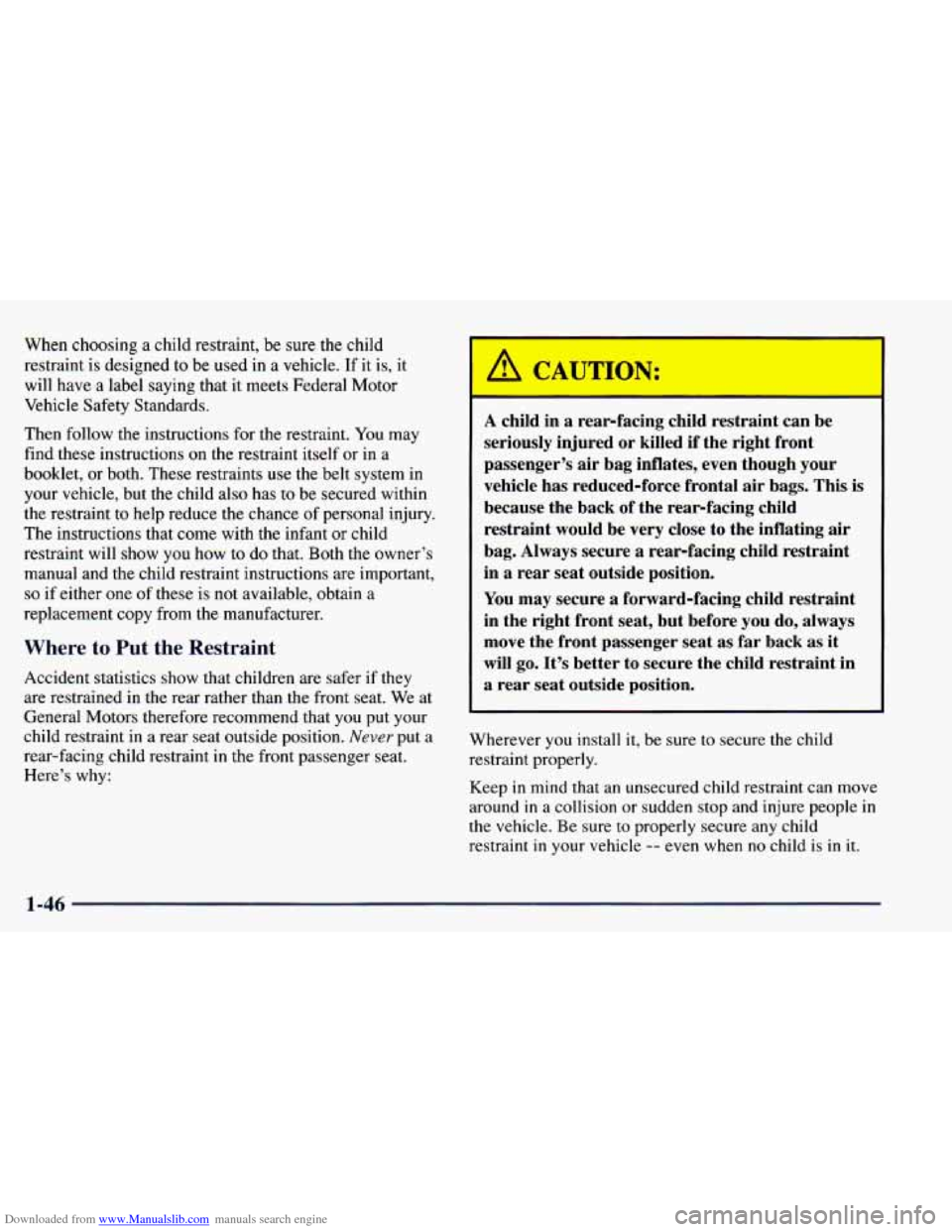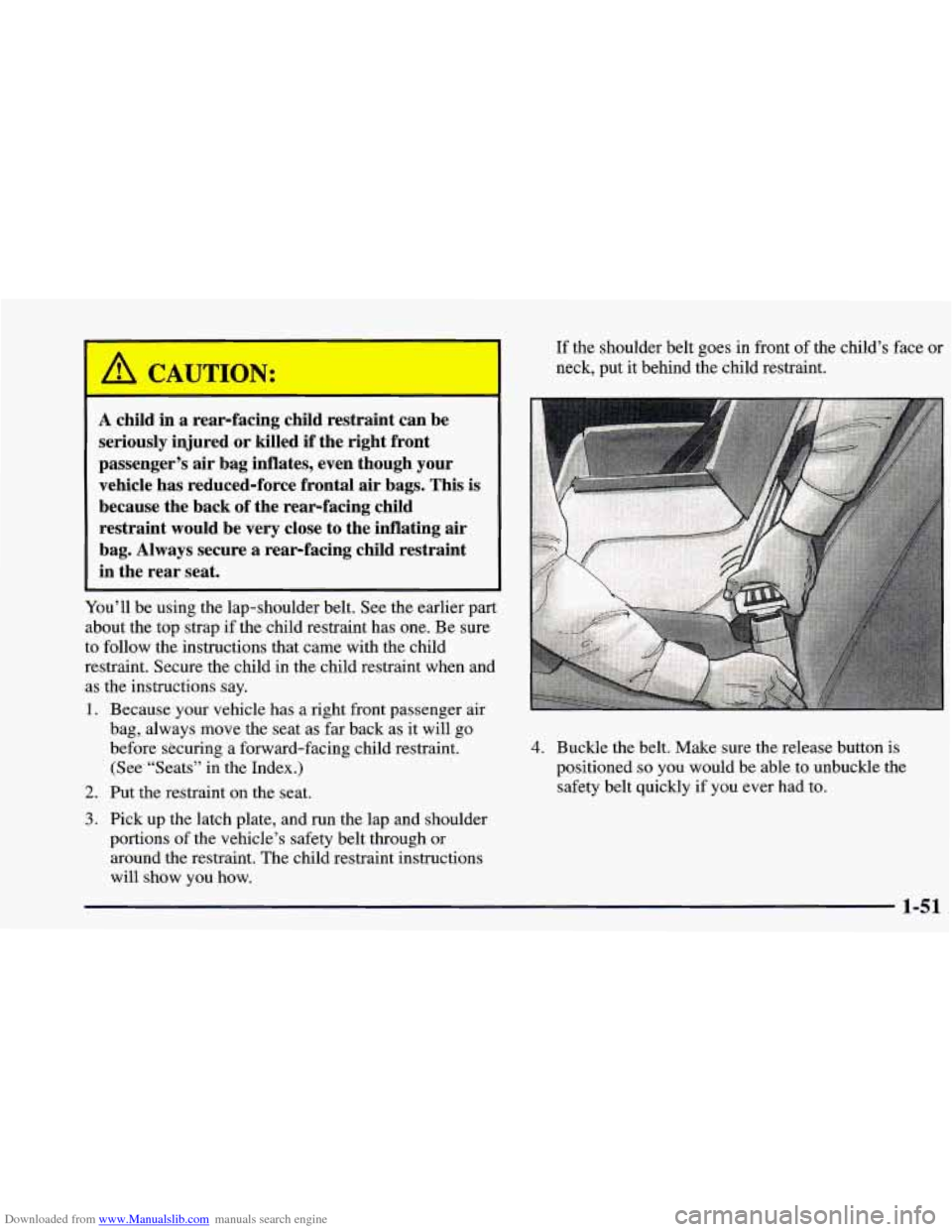Page 62 of 416

Downloaded from www.Manualslib.com manuals search engine When choosing a child restraint, be sure the child
restraint is designed to be
used in a vehicle. If it is, it
will have
a label saying that it meets Federal Motor
Vehicle Safety Standards.
Then follow the instructions for the restraint. You may
find these instructions on the restraint itself or in a
booklet, or both. These restraints use the belt system in
your vehicle, but the child also has to be secured within
the restraint to help reduce the chance
of personal injury.
The instructions that come with the infant or child
restraint will show
you how to do that. Both the owner’s
manual and the child restraint instructions are important,
so if either one of these is not available, obtain a
replacement copy
from the manufacturer.
Where to Put the Restraint
Accident statistics show that children are safer if they
are restrained in the rear rather than the front seat. We at
General Motors therefore recommend that
you put your
child restraint in a rear seat outside position.
Never put a
rear-facing child restraint in the front passenger seat.
Here’s why:
f
’ A child in a rear-facing child restraint can be
seriously injured or killed if the right front
passenger’s air bag inflates, even though your
vehicle has reduced-force frontal air bags. This is
because the back
of the rear-facing child
restraint would be very close to the inflating air
bag. Always secure a rear-facing child restraint
in
a rear seat outside position.
You may secure a forward-facing child restraint
in the right front seat, but before you do, always
move the front passenger seat as far back as it
will
go. It’s better to secure the child restraint in
a rear seat outside position.
Wherever
you install it, be sure to secure the child
restraint properly.
Keep in mind that an unsecured child restraint can move
around
in a collision or sudden stop and injure people in
the vehicle. Be sure
to properly secure any child
restraint
in your vehicle -- even when no child is in it.
1-46
Page 63 of 416
Downloaded from www.Manualslib.com manuals search engine Top Strap
Don’t use the front set of tie-down brackets. Anchor
the
If your child restraint has a top strap, it should be
anchored. Anchor brackets for the rear outside seat
positions are located on the floor in the cargo area. top strap
to the
rearmost bracket on the same side of the
vehicle as the child restraint.
Once you have the top strap anchored, you’ll be ready to
secure the child restraint itself.
1-47
Page 64 of 416
Downloaded from www.Manualslib.com manuals search engine Securing a Child Restraint in a Rear
Outside Seat Position
You’ll be using the lap-shoulder belt. See the earlier part
about the top strap
if the child restraint has one. Be sure
to follow the instructions that came with the child
restraint. Secure the child in the child restraint when and
as the instructions say.
1. Put the restraint on the seat.
2. Pick up the latch plate, and run the lap and shoulder
portions
of the vehicle’s safety belt through or
around the restraint. The child restraint instructions
will show
you how.
If the shoulder belt goes in front of the child’s face
or
neck, put it behind the child restraint.
3. Buckle the belt. Make sure the release button is
positioned
so you would be able to unbuckle the
safety belt quickly if
you ever had to.
1-48
Page 65 of 416
Downloaded from www.Manualslib.com manuals search engine 4. Pull the rest of the shoulder belt all the way out of
the retractor to set the lock.
5. To tighten the belt, feed the shoulder belt back into
the retractor while you push down on the child
restraint.
If you’re using a forward-facing child
restraint, you may find
it helpful to use your knee
to push down on the child restraint as you tighten
the belt.
6. Push and pull the child restraint in different
directions to be sure
it is secure.
1-49
Page 66 of 416
Downloaded from www.Manualslib.com manuals search engine To remove the child restraint, just unbuckle the vehicle’s
safety belt and let it
go back all the way. The safety belt
will move freely again and be ready to work for an adult
or larger child passenger.
Center Seat Positions (4-Door Models)
Don’t use child restraints in these positions. The
restraints won’t work properly.
Securing a Child Restraint in the Right
Front Seat
Position
Your vehicle has a right front passenger air bag. Never
put a rear-facing child restraint in this seat. Here’s why:
1-50
Page 67 of 416

Downloaded from www.Manualslib.com manuals search engine If the shoulder belt goes in front of the child’s face or
A child in a rear-facing child restraint can be
seriously injured or killed if the right front
passenger’s air bag inflates, even though your
vehicle has reduced-force frontal air bags. This is
because the back of the rear-facing child
restraint would be very close to the inflating air
bag. Always secure a rear-facing child restraint
in the rear seat.
You’ll be using the lap-shoulder belt. See the earlier part
about the top strap if the child restraint has one. Be sure
to follow the instructions that came with the child
restraint. Secure the child in the child restraint when and
as the instructions say.
1. Because your vehicle has a right front passenger air
bag, always move the seat as far back as it will go
before securing a forward-facing child restraint.
(See “Seats” in the Index.)
2. Put the restraint on the seat.
3. Pick up the latch plate, and run the lap and shoulder
portions of the vehicle’s safety belt through or
around the restraint. The child restraint instructions
will show you how. neck, put
it behind the child restraint.
4. Buckle the belt. Make sure the release button is
positioned
so you would be able to unbuckle the
safety belt quickly if you ever had to.
1-51
Page 68 of 416
Downloaded from www.Manualslib.com manuals search engine 5. Pull the rest of the shoulder belt all the way out of
the retractor to set the lock. 6.
7.
To tighten the belt, feed the shoulder belt back into the
retractor while you push down on the child restraint.
You may find it helpful to use your knee to push down
on the child restraint as you tighten the belt.
Push and pull the child restraint in different
directions to be sure it is secure.
To remove the child restraint, just unbuckle the vehicle’s
safety belt and let it go back all the way. The safety belt
will move freely again and be ready to work for an adult
or larger child passenger.
Page 79 of 416
Downloaded from www.Manualslib.com manuals search engine Power Door Locks (If Equipped) Rear Door Security Lock (If Equipped)
If your vehicle has power door
locks, the switch is
located on the armrest. Remove the ignition key and
press
LOCK to lock all the doors at once.
To unlock the doors, press the raised area next to the
key symbol.
On four-door models, the lever on each rear door works
only that door’s lock. With
this feature, you
can
lock the rear doors so they
can’t be opened from the
inside
by passengers.
Move the lock up to lock
the doors and down to
release the door locks.
Lockout Prevention
To protect you from locking your key in the vehicle, this
feature stops the power door locks from locking when
the keys are in the ignition and a door is open.
If the power lock switch is pressed when a door is open
and the key is in the ignition, all the doors will lock and
the driver’s door will unlock.
2-5